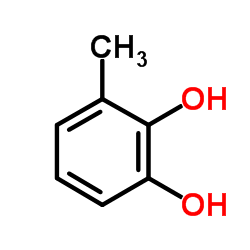

3-甲基邻苯二酚结构式

|
常用名 | 3-甲基邻苯二酚 | 英文名 | 3-Methylcatechol |
|---|---|---|---|---|
| CAS号 | 488-17-5 | 分子量 | 124.137 | |
| 密度 | 1.2±0.1 g/cm3 | 沸点 | 240.9±20.0 °C at 760 mmHg | |
| 分子式 | C7H8O2 | 熔点 | 65-68 °C(lit.) | |
| MSDS | 中文版 美版 | 闪点 | 116.7±16.4 °C | |
| 符号 |

GHS07 |
信号词 | Warning |
|
Effects of plant species, stage of maturity, and level of formic acid addition on lipolysis, lipid content, and fatty acid composition during ensiling.
J. Anim. Sci. 93 , 4408-23, (2015) Forage type and management influences the nutritional quality and fatty acid composition of ruminant milk. Replacing grass silage with red clover (RC; L.) silage increases milk fat 18:3-3 concentration. Red clover has a higher polyphenol oxidase (PPO) activit... |
|
|
Characterization of catechol 2,3-dioxygenase from Planococcus sp. strain S5 induced by high phenol concentration.
Acta Biochim. Pol. 59(3) , 345-51, (2012) This study aimed at characterization of a new catechol 2,3-dioxygenase isolated from a Gram-positive bacterium able to utilize phenol as the sole carbon and energy source. Planococcus sp. strain S5 grown on 1 or 2 mM phenol showed activity of both a catechol ... |
|
|
Electrochemical synthesis of novel 1,3-indandione derivatives and evaluation of their antiplatelet aggregation activities.
Iran. J. Pharm. Res. 12 , 91-103, (2013) Electrochemical oxidation of some selected catechol derivatives, using cyclic voltammetry, in the presence of different 2-aryl-1,3-indandiones as nucleophiles, resulted in electrochemical synthesis of new 1,3- indandione derivatives in an undivided cell in go... |
|
|
Selection for growth on 3-nitrotoluene by 2-nitrotoluene-utilizing Acidovorax sp. strain JS42 identifies nitroarene dioxygenases with altered specificities.
Appl. Environ. Microbiol. 81(1) , 309-19, (2014) Acidovorax sp. strain JS42 uses 2-nitrotoluene as a sole source of carbon and energy. The first enzyme of the degradation pathway, 2-nitrotoluene 2,3-dioxygenase, adds both atoms of molecular oxygen to 2-nitrotoluene, forming nitrite and 3-methylcatechol. All... |
|
|
New insights on toluene biodegradation by Pseudomonas putida F1: influence of pollutant concentration and excreted metabolites.
Appl. Microbiol. Biotechnol. 74(4) , 857-66, (2007) The influence of toluene concentration on the specific growth rate, cellular yield, specific CO(2), and metabolite production by Pseudomonas putida F1 (PpF1) was investigated. Both cellular yield and specific CO(2) production remained constant at 1.0 +/- 0.1 ... |
|
|
Cyclobotryoxide, a phytotoxic metabolite produced by the plurivorous pathogen Neofusicoccum australe.
J. Nat. Prod. 75(10) , 1785-91, (2012) Two isolates of Neofusicoccum australe belonging to ITS haplotypes H4 and H1 and associated with grapevine cordon dieback and branch dieback of Phoenicean juniper, respectively, have been shown to produce in vitro structurally different secondary metabolites.... |
|
|
Characterization of a novel thermostable Mn(II)-dependent 2,3-dihydroxybiphenyl 1,2-dioxygenase from a polychlorinated biphenyl- and naphthalene-degrading Bacillus sp. JF8.
J. Biol. Chem. 278(24) , 21483-92, (2003) A novel thermostable Mn(II)-dependent 2,3-dihydroxybiphenyl-1,2-dioxygenase (BphC_JF8) catalyzing the meta-cleavage of the hydroxylated biphenyl ring was purified from the thermophilic biphenyl and naphthalene degrader, Bacillus sp. JF8, and the gene was clon... |
|
|
Isolation and partial characterization of an extradiol non-haem iron dioxygenase which preferentially cleaves 3-methylcatechol.
Biochem. J. 266(2) , 605-9, (1990) A purification procedure has been developed for an extradiol dioxygenase expressed in Escherichia coli, which was originally derived from a Pseudomonas putida strain able to grow on toluidine. Physical and kinetic properties of the enzyme have been investigat... |
|
|
Response of Pseudomonas putida F1 cultures to fluctuating toluene loads and operational failures in suspended growth bioreactors.
Biodegradation 19(6) , 897-908, (2008) The response of Pseudomonas putida F1 to process fluctuations and operational failures during toluene biodegradation was evaluated in a chemostat suspended growth bioreactor. The ability of P. putida F1 to rapidly increase its specific toluene degradation cap... |
|
|
Substrate binding mechanism of a type I extradiol dioxygenase.
J. Biol. Chem. 285(45) , 34643-52, (2010) A meta-cleavage pathway for the aerobic degradation of aromatic hydrocarbons is catalyzed by extradiol dioxygenases via a two-step mechanism: catechol substrate binding and dioxygen incorporation. The binding of substrate triggers the release of water, thereb... |